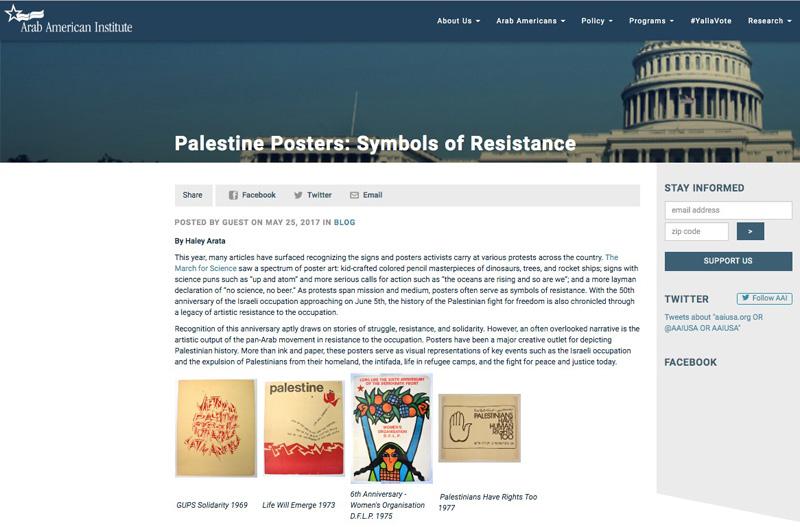By Haley Arata
This year, many articles have surfaced recognizing the signs and posters activists carry at various protests across the country. The March for Science saw a spectrum of poster art: kid-crafted colored pencil masterpieces of dinosaurs, trees, and rocket ships; signs with science puns such as “up and atom” and more serious calls for action such as “the oceans are rising and so are we”; and a more layman declaration of “no science, no beer.” As protests span mission and medium, posters often serve as symbols of resistance. With the 50th anniversary of the Israeli occupation approaching on June 5th, the history of the Palestinian fight for freedom is also chronicled through a legacy of artistic resistance to the occupation.
Recognition of this anniversary aptly draws on stories of struggle, resistance, and solidarity. However, an often overlooked narrative is the artistic output of the pan-Arab movement in resistance to the occupation. Posters have been a major creative outlet for depicting Palestinian history. More than ink and paper, these posters serve as visual representations of key events such as the Israeli occupation and the expulsion of Palestinians from their homeland, the intifada, life in refugee camps, and the fight for peace and justice today.
Some of the poster images have changed meaning over time as Palestinians have sought to reclaim important symbols and images. For example, the famous “Visit Palestine” poster was designed in 1936 by the Tourist Association of Palestine, a Zionist development agency. A colorful scene of Jerusalem and the Dome of the Rock, the poster originally aimed to attract more Jewish immigrants to Palestine. Palestinians soon repurposed the poster, changing its meaning to reflect Palestinian existence and legitimacy after the failure of the Oslo process and the second intifada. Contemporary artists have made various iterations of the poster, some depictions with a tall wall blocking the view of the Dome of the Rock and the Old City, others with a bulldozer or Israeli soldiers charging the city.
The Palestinian Poster Project Archives is home to thousands of Palestine poster artwork. What started as Dan Walsh’s master’s thesis soon turned into a digital database for posters dating back over a century. Within the Palestine poster genre are those either designed by Palestinians, with the word ‘Palestine’ in any language, published in the geographical territory of Palestine, or that mention Zionism or anti-Zionism in the time period since 1897. Although many of the artists are Palestinian, artists from around the world contribute poster designs to the Palestinian freedom movement.
Artists combine colors, words, and symbols to display different messages and images on each poster. Iconography of doves and children evoke peace and tolerance; chains, shackles, and guns symbolize pain and violence; and clenched fists illustrate the demands for freedom and equality. One sign reads, “Solidarity” followed by a list: “Vietnam, Palestine, Rhodesia, South Africa, Latin America”, indicating a sense of a shared struggle across the globe. Another highlights the timeless nature of the resistance with, “Palestine, the struggle for justice is still young.” And another reads, “Palestinians Have Human Rights Too” in Arabic, English, and Hebrew and shows a dove in the shape of a hand. This image was designed by Kamal Boullata (who was honored with a Special Recognition at AAI’s Gibran Gala this past April) and was used as a bumper sticker design until it was later converted into a poster.
AAI President Dr. James Zogby has a collection of Palestine posters. Housed in his attic for years, the pieces are worn with age and a history of resilience. Although some are slightly stained, the posters serve as a reminder that the struggle for a free Palestine is alive today.
Haley Arata is a Summer 2017 Intern at the Arab American Institute

